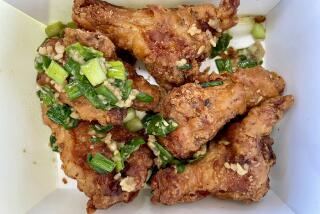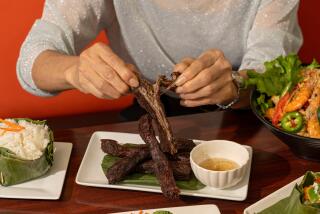Baby Bok Is a Thing of Choy
- Share via
Ah, babies. In nearly everything that grows on this planet--from tots to chicks to teeny carrots--the littlest are irresistible.
Baby bok choy is no exception to the rule. It’s a curvy little bunch, four to five inches long, of pale green chard-like stalks crowned with smooth, dark-green leaves. In China, the little beauties are usually chopped or sliced and stir-fried. But the whole vegetables are so aesthetic, I prefer to slice them in half lengthwise and admire their interior design, a tracery resembling a lyre.
Eat the stalks and leaves raw or briefly cooked. Their delicate flavor has a hint of mustard--were the bok choy to grow older, the mustard would have snap. Beguiling flavor aside, baby bok choy is very low in calories and a rich source of beta carotene and other valuable nutrients.
Now, the many names of Asian vegetables can make you crazy. They’ve been raised for centuries in many countries, and the great number of varieties, multiplied by the many languages involved and the difficulty of transliterating them, makes for a tangle.
*
If your neighborhood supermarket has an imaginative produce selection, you’ll find baby bok choy now in early spring and again in fall (its main seasons). But in the produce section of a Chinese market, the sign may say baby bok choy or baby pak choi or Shanghai pak choi .
On the plate, it doesn’t matter what a vegetable’s name is as long as it’s tasty. But for the garden, you need to have a name to order seeds. Joy Larkcom, experienced plantsman and scholarly author of the excellent “Oriental Vegetables,” says bok choy is one of the Cantonese terms for heading Chinese cabbage--what we call michihili or pe-tsai (the barrel shapes) and napa or wong bok (the elongated shapes). She also notes that bok choy is one of the Cantonese terms for pak choi , another brassica. Coincidentally, heading Chinese cabbage and pak choi are siblings, both forms of field mustard.
Compare baby bok choy with full-grown pak choi in the Chinese market--or compare pictures in a catalogue--and it’s clear that our baby bok choy is baby pak choi in disguise.
Yes?
So in a catalogue that has Asian seeds, if you don’t see baby bok choy (and you probably won’t), look under pak choi , which will probably be under Chinese cabbage. To grow wonderful baby pak choi /bok choy, choose a pak choi cultivar with green leaf stems (more properly called petioles). By and large, the green variety is more refined than the white-stemmed types. In China, the stalks are the favored part of the vegetable. But the leafy tips are the most nourishing because their green is darker (more beta carotene).
*
Ching-Chiang (Long Green Petiole) is a delectable cultivar whose branches are equally divided between crisp pale-green stalks and tender medium-green leaves. It’s a particularly valuable cultivar, because it’s resistant to heat. Pak choi and its relatives are considered cool-season vegetables because they start to flower when days grow hot, and flowering makes the vegetable toughen.
Ching-Chiang can be sown in all but the hottest summer parts of Southern California from spring through fall without sending up a flower, a big plus. Mei Qing Choi (pronounced may ching ) is a particularly fetching baby, a vase-shaped hybrid that has resistance to both heat and cold. Sow it in spring, late summer and autumn.
There’s even more that’s delightful about baby bok choy/ pak choi . Unlike European cabbages, which prefer to be transplanted from where they’ve germinated to where they’ll grow, these mustards are unassuming country folk and want no special attention. They’re very easy to grow. Just drop seeds into fertile moisture-retentive soil and step back. Keep the soil moist, see that there’s shade in the heat of the day, shelter with an insect-weight floating row cover if you’ve had flea beetles, and patrol for slugs. Pick when the bunches are four to five inches tall--this can be a month from sowing!
Ideally, baby bok choy/ pak choi is grown in a two-gallon container. Set plants of sweet alyssum around the pot every four inches, then sow a few seeds in the centers of the spaces between the alyssum. During the first couple of weeks, snip the leaves of all but the strongest seedlings at soil level until the one strongest plant remains.
*
In another pot, you could be growing “chicken feathers.” This is what the Chinese call the leaves on a pak choi plant that are even smaller than baby-size. Sow a pinch of seeds in a pot or patch in the garden. If the weather is cool, they’ll be at the chicken-feather stage in about two weeks. Harvest and sprinkle through delicate salads.
The younger the plant, the subtler its flavor. Getting a sense of the unadulterated taste of a vegetable is the first thing you should do after bringing it into your kitchen. Next decide whether you want its flavor simple or enhanced. Which reminds me of the thorn in my side. More and more, I find in these days where “big tastes” are the vogue, that what one palate praises as subtle, another condemns as bland.
My mother, for example, is fond of seasoning--on some things. She’s mad about curries and chiles so hot they make my eyes blurry, but she wants to savor the delicacy of baby bok choy. For that reason, she serves it raw as salad. In spring, she sprinkles lemon juice and a thread of walnut oil over a half of baby bok choy on a bed of watercress garnished with thin unpeeled wedges of russet pear and flecks of finely diced pimiento.
By contrast, my husband prefers baby bok choy my Thai-inspired way. I blanch the halves in boiling water for two minutes--every part turns bright-green and the fleshy stalks soften slightly, yet they’re still crunchy enough to need a knife for cutting. I saute shallots, dried New Mexico chiles and lots of garlic--all finely chopped--in a little peanut oil until the chiles are lightly crisp, then blend in extra chunky peanut butter and chicken broth to make a thick sauce. I smooth this into the crevices of the bok choys and serve them sprinkled with a few toasted sesame seeds at room temperature as a first course.
*
When pak choi has been in the ground longer, though, you’ll find that, like chard, it’s two vegetables in one: stalks and leaves. The stalks need longer cooking, so you’ll cut the greens off the stalks. In a stir-fry, the stalks are added to the pan first; when they’re nearly ready, the leaves are tossed in. Or you can cook the stalks any way you would cook celery, and cook the greens any way you would cook spinach or chard.
What a splendid vegetable--sow your babies soon!
*
Sources:
Fresh at many major supermarkets.
Seeds of Ching-Chiang (Long Green Petiole) from Evergreen Y. H. Enterprises, Box 17538, Anaheim, Calif. 92817; Mei Qing Choy from Nichols Garden Nursery, 1190 N. Pacific Highway, Albany, Ore. 97321-4580.
Insect-weight floating row cover (Agrofabric Pro 10 insect barrier) from Peaceful Valley Farm Supply, Box 2209, Grass Valley, Calif. 95945.
Thompson is the author of the recently released “The Kitchen Garden” (Bantam Books: $19.95). She can be reached via TimesLink e-mail at bubq86e. For information on TimesLink, call (800) 792-LINK, ext. 274.
More to Read
Eat your way across L.A.
Get our weekly Tasting Notes newsletter for reviews, news and more.
You may occasionally receive promotional content from the Los Angeles Times.










